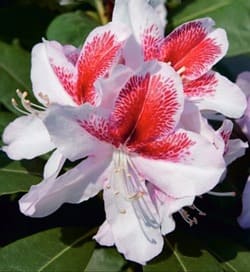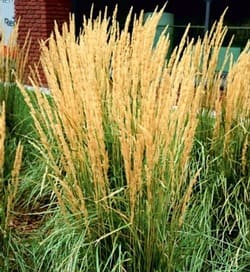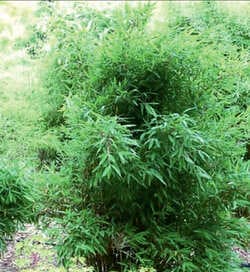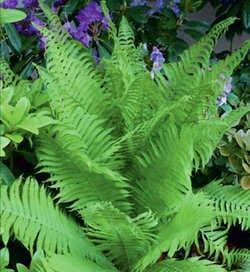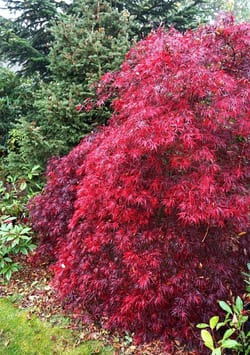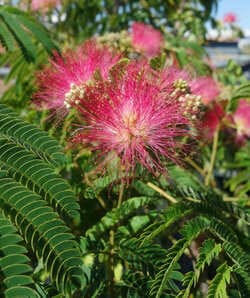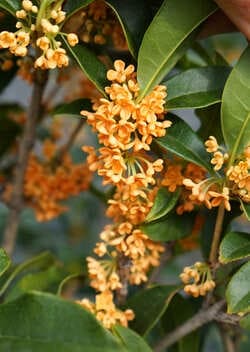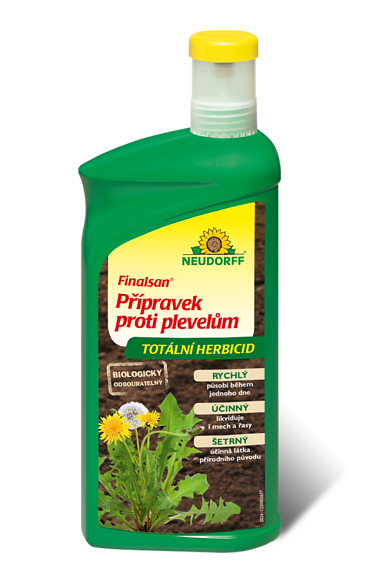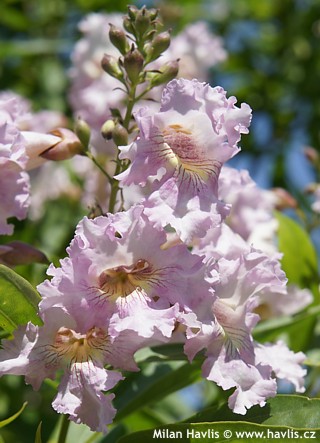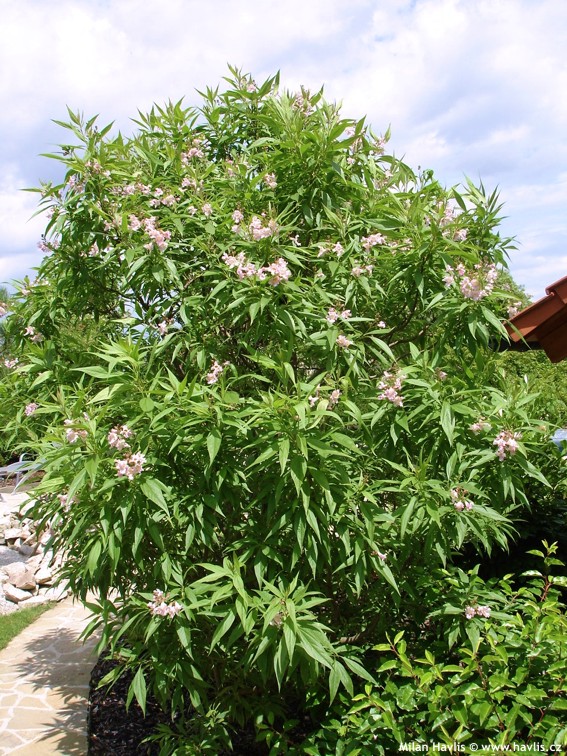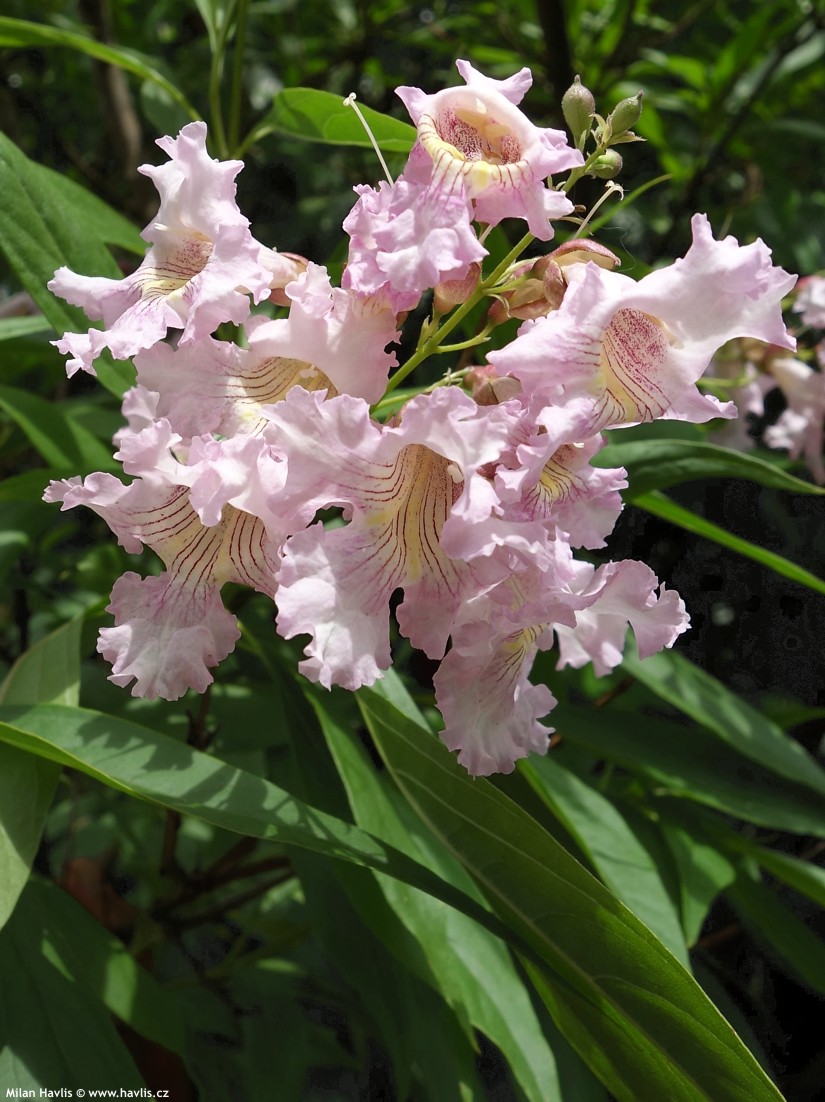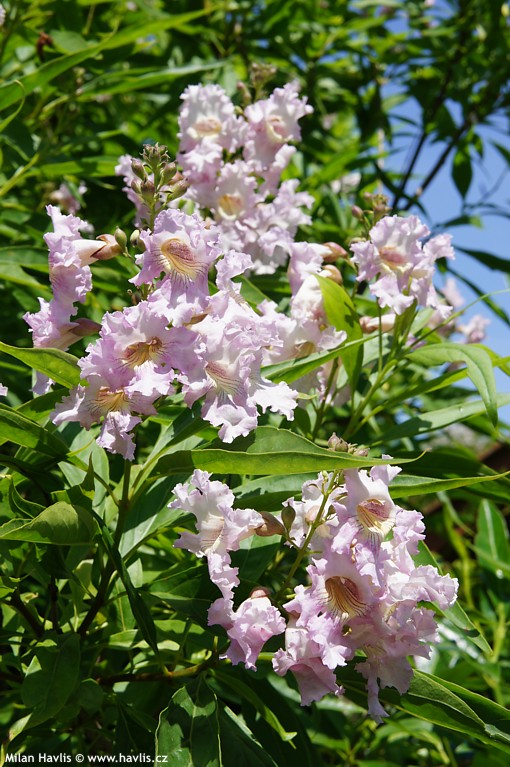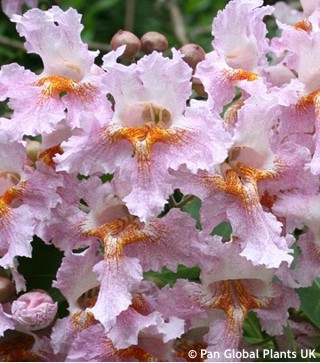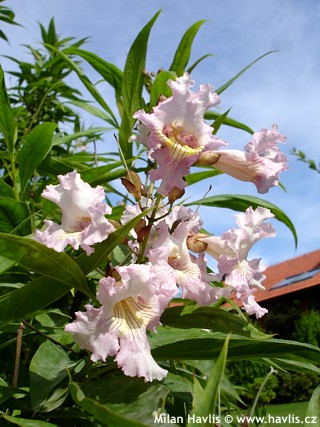×Chitalpa tashkentensis 'Minsun' SUMMER BELLS chitalpa
Chitalpa
If you are looking for trees that bloom in summer, chitalpa is an ideal candidate. Its story is fascinating and begins in 1964 at the botanical garden in Tashkent, then the heart of Soviet botanical science. Uzbek botanist Nikolai Fyodorovich Rusanov had a bold dream: to create a tree that would combine the exotic beauty of the desert willow (Chilopsis linearis) with the resilience of catalpas (Catalpa bignonioides, later also C. speciosa and C. ovata). Both parents come from North America, but their worlds are very different – Chilopsis is a shrub or slender tree of semi‑deserts and deserts, accustomed to scorching sun and drought, while Catalpa is a majestic tree with huge leaves and abundant flower clusters, thriving in moist soils. To unite these contrasts required long studies of catalpa phenology and the application of controlled pollination techniques within intergeneric crossing. A true scientist must be patient, and Rusanov was – after many attempts he succeeded and obtained viable seeds. Thus, the first nothogenetic hybrid was born: ×Chitalpa tashkentensis. This achievement was a sensation in the botanical world: the hybrid carried beautiful flowers over a long period, elegant foliage, and moreover gained resistance to drought and heat.
Although the Cold War still raged in the 1960s, the later détente of the 1970s also extended to scientific exchange. Robert Hebb of the New York Botanical Garden had been waiting for that moment, and in 1977 he legally exported the first two clonal lines to North America. These gave rise to the first known cultivars:
‘Pink Dawn’ – with delicate pink flowers blooming from May to September,
‘Morning Cloud’ – with white to pale pink flowers resembling clouds on the branches, though with limited resilience.
The official botanical name ×Chitalpa tashkentensis was established only in 1991 by Thomas Elias and Walter Wisura of Rancho Santa Ana Botanic Garden. Since then, the hybrid has spread across the United States, especially in the drier southwest, where it became a popular urban tree thanks to its tolerance of heat, drought, and alkaline soils. Chitalpa reached Europe only in the 1980s and took some time to find its admirers. In England and the coastal countries of the Benelux, winters may be mild, but summers are cooler and less sunny, which does not encourage abundant flowering. In continental Europe, including Central Europe, summers are hot and sunny, and here chitalpas bloom richly and reliably. Logically, one might expect it to be popular in the Mediterranean, where conditions are ideal, but for some reason it remains a marginal, collector’s tree there, still waiting to be discovered – perhaps because they already have plenty of other summer‑flowering trees 😊.
The cultivar SUMMER BELLS of chitalpa boasts abundant and prolonged flowering throughout summer, from June to August. The inflorescences are upright clusters shaped like slender pyramids, reaching 10 to 20 cm in height, composed of exquisite orchid‑like blossoms that combine light pink to lilac tones with a yellowish throat marked by striking wine‑coloured veins. They are truly enchanting in their exotic delicacy – and as a bonus, they are fragrant! A sweet, subtle, unobtrusive scent spreads around them especially in the afternoon and evening.
It forms tall, multi‑stemmed shrubs reaching about 6 metres in height and 4 metres in width at maturity, or it can be grafted onto catalpa rootstocks into standard tree form, which may add about 2 metres more. The multi‑stemmed form is particularly elegant. It is a deciduous woody plant with leaves up to 20 cm long, broadly lanceolate, which with a little imagination resemble those of peach trees, just wider. They are bright green in summer and briefly turn yellow in autumn. During strong temperature fluctuations and humid weather at the beginning of summer, leaves of weaker plants may be sensitive to powdery mildew (a grey‑white coating). If this occurs, treat promptly with a suitable fungicide – even natural‑based ones work. The cultivar SUMMER BELLS was selected and introduced in 1998 by the French nursery Minier as a variety with deeper flower colour and longer flowering season. It carries only Dutch legal protection registration no. 175787 from 2011.
For abundant flowering, chitalpa always needs full sun and a warm summer. It tolerates neighbouring plants around the trunk and does not have aggressive roots. It will grow in almost any well-drained soil, acidic or alkaline, and is not demanding in nutrients. It withstands longer periods of drought but does not tolerate waterlogging. In youth it grows fairly quickly (30–50 cm per year), and once it begins to flower, growth slows down by half and the crown thickens and shapes nicely. It does not require pruning, but shaping is possible – prune always in spring after frosts (it flowers on new wood) and only up to one third of branch length. Deeper (rejuvenation) pruning leads to regeneration and production of long branches over one metre, and without supplementary phosphorus‑based fertilisation it may not flower that year. It leafs out very late, so do not be surprised if during a cool spring it is still bare at the beginning of May. Its hardiness has been verified as reliable down to –27 °C and reportedly even withstands –29 °C (USDA zone 5). Only once, during a severely frosty winter combined with all‑day sun, did some specimens suffer slight sunscald on exposed branches and trunks, but they regenerated over time. It requires no winter protection.
Last update 05-12-2008; 25-02-2010; 24-11-2025

1 080 Kč
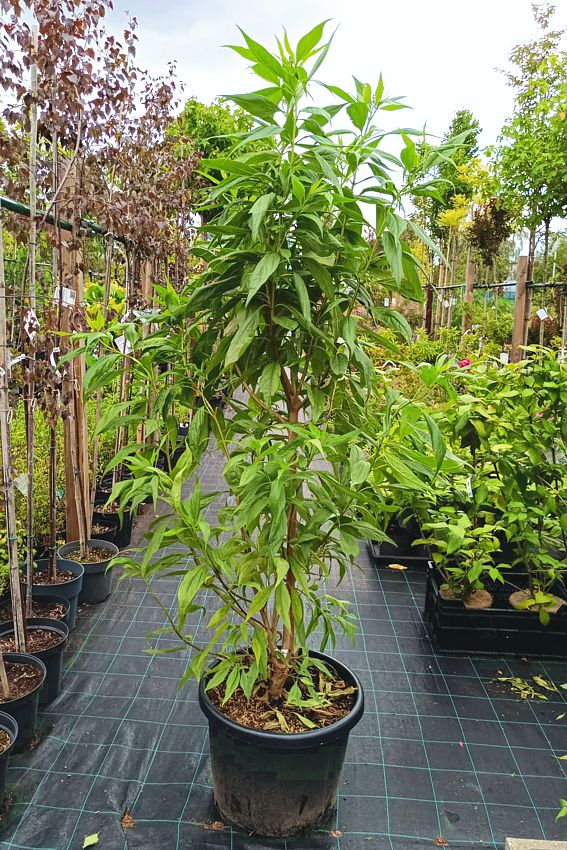
6 040 Kč
Goods are shipped all over Europe. For Russia and U.K. and for further details please read about SHIPPING OPTIONS HERE.
Are you interested in a serious discount for orders NOV-FEB? Check your options here.
THE PRICES INCLUDE VAT of 15%. For quick conversion you can use 1 CZK = approx. 0.04 EUR
- STANDARD QUALITY - Plants of this group are 1st class quality with number of branches and overall density adequate to their size and age, considering they were container grown.
- DE LUXE QUALITY - This label guarantees a luxurious quality of manually selected plants that, compared to their height and age, are exceptionally dense and beautiful.
- EXTRA - These plants are usually mature and bigger specimens with exceptional overall appearance.
- STANDARD (as described in the plant form) means a tree with a trunk of 190-210 cm and a crown at the top, unless specified differently. The commercial size for trees is their girth measured in the height of 1m from ground.
- HOBBY - These plants are of the same quality as our standard-quality plants but younger and therefore cheaper.
- SHRUB - a woody plant with branches growing bushy from the ground level.
- HALF-STANDARD or MINI-STANDARD - a small tree with shorter trunk, its size is usually specified.
- FEATHERED - These are trees with branches growing already from the base of the trunk and up along the stem.
- GRASSES and PERENNIALS - Sizes given usually read the diameter of the pot or the clump, as specified.












